soft matter
Ordering Dynamics of Soft Matter
1) Static and Dynamic Structures in Ordering of Soft Micelles
2) Dynamics of order-order transitions in surfactant assemblies
3) Shear induced morphology transition of surfactant assemblies
4) Ordering process in the induction period of crystallization of polymer
5) Polymer crystallization from ultra-thin film
Structure Formation of Soft Matter Complex System
1) Morphology transition of molecular assemblies induced by guest particles
2) Morphology transition of membranes induced by polymer confinement
3) Depletion interaction in rod particle and semi-flexible polymer mixture
Ordering Dynamics of Soft Matter
1) Static and Dynamic Structures in Ordering of Soft Micelles
 The crystallization of spherical particles is one of the most fundamental
first-order phase transitions. The static and dynamic structures of hard
spheres in the crystallization have been well understood. By introducing
soft inter-particle interactions, the static and dynamic structures are
significantly modified. For example, surfactant micelles show the non-close-packed
lattice, body centered cubic (BCC) and A15 (Kelvin polygons) lattice in
the phase diagram and characteristic slow dynamics in the fluid and crystal
phases. We have investigated the static and dynamic structures in ordering
of soft micelles using light scattering, X-ray scattering, neutron scattering
and rheology measurements.
The crystallization of spherical particles is one of the most fundamental
first-order phase transitions. The static and dynamic structures of hard
spheres in the crystallization have been well understood. By introducing
soft inter-particle interactions, the static and dynamic structures are
significantly modified. For example, surfactant micelles show the non-close-packed
lattice, body centered cubic (BCC) and A15 (Kelvin polygons) lattice in
the phase diagram and characteristic slow dynamics in the fluid and crystal
phases. We have investigated the static and dynamic structures in ordering
of soft micelles using light scattering, X-ray scattering, neutron scattering
and rheology measurements.
[Related papers]
Static and Dynamic Structures of Spherical Nonionic Surfactant Micelles during the Disorder-Order Transition
M. Imai, I. Yoshida, T. Iwaki, and K. Nakaya
J. Chem. Phys. 122, 044906 (2005)
Diffusion of surfactant micelles in fluid and crystal phases
M. Imai, M. Kurimoto, F. Matsuura, Y. Sakuma, and T. Kawakatsu
Soft Matter, accepted (DOI:10.1039/C2SM07122C)
2)Dynamics of order-order transitions in surfactant assemblies
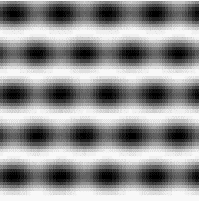 The surfactant molecule composed of the hydrophilic and the hydrophobic
groups forms various self-assemblies in water, such as micelle, lamellae,
cylinder, gyroid and so on. We have investigated the phase transition dynamics
between the ordered phases especially focus on the pre-transition and the
intermediate structures. Prior to the lamellar to gyroid transition, a
least stable fluctuation mode appears in lamellar membrane and then the
intermediate hexagonal perforated lamellar structure is stabilized. The
perforated lamellar structure transform to the gyroid keeping a geometrically
epitaxial relationship. Such a characteristic intermediate structures are
a unique feature of phase transitions of soft matter.
The surfactant molecule composed of the hydrophilic and the hydrophobic
groups forms various self-assemblies in water, such as micelle, lamellae,
cylinder, gyroid and so on. We have investigated the phase transition dynamics
between the ordered phases especially focus on the pre-transition and the
intermediate structures. Prior to the lamellar to gyroid transition, a
least stable fluctuation mode appears in lamellar membrane and then the
intermediate hexagonal perforated lamellar structure is stabilized. The
perforated lamellar structure transform to the gyroid keeping a geometrically
epitaxial relationship. Such a characteristic intermediate structures are
a unique feature of phase transitions of soft matter.
[Related papers]
Kinetic Pathway of Lamellar -> Gyroid Transition: Pretransition and Transient States.
M. Imai, A. Saeki, T. Teramoto, A. Kawaguchi, K. Nakaya, T. Kato, and K. Ito
J. Chem. Phys. 115, 10525 (2001).
Dynamical Nature of Least Stable Fluctuation Modes of Lamellar Structure Observed in a Nonionic Surfactant/Water System
M. Imai, K. Nakaya, T. Kawakatsu, and H. Seto
J. Chem. Phys. 119, 8103-8111 (2003).
Kinetic pathway to double gyroid structure
M. Imai, K. Sakai, M. Kikuchi, K. Nakaya, A. Saeki, and T. Teramoto
J. Chem. Phys. 122, 214906(1-10)(2005).
3)Shear induced morphology transition of surfactant assemblies
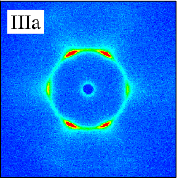 Since the surfactant assemblies are stabilized by relatively weak interactions,
they easily deform their morphologies when subjected to external fields,
such as a shear field. When we apply the shear field to the anisotropic
lamellar assemblies, the planar membranes often transform to the isotropic
multilamellar vesicles (onions) with two dimensional hexagonally close-packed
configuration. We have investigated the shear-induced ordering of onions
in a nonionic surfactant (C12E4) system using a small-angle light scattering
and a small-angle X-ray scattering technique.
Since the surfactant assemblies are stabilized by relatively weak interactions,
they easily deform their morphologies when subjected to external fields,
such as a shear field. When we apply the shear field to the anisotropic
lamellar assemblies, the planar membranes often transform to the isotropic
multilamellar vesicles (onions) with two dimensional hexagonally close-packed
configuration. We have investigated the shear-induced ordering of onions
in a nonionic surfactant (C12E4) system using a small-angle light scattering
and a small-angle X-ray scattering technique.
[Related papers]
Shear-Induced Ordering of Lamellar and Gyroid Structures Observed in a Nonionic Surfactant System.
M. Imai, K. Nakaya, and T. Kato
European Physical Journal E, 5, 391-402 (2001).
Order-disorder transition of nonionic onions under shear flow
Y. Suganuma, M. Imai, T. Kato, U. Olsson, and T. Takahashi
Langmuir 26, 7988-7995 (2010).
4)Ordering process in the induction period of crystallization of polymer
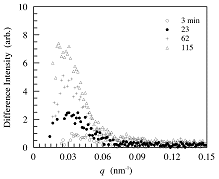 During an induction period of the polymer crystallization, randomly entangled
polymer chains forms the regular aligned crystals with the critical size.
During the induction period of crystallization of poly(ethylene terephthalate),
the coupling of density and orientation fluctuations play an important
role, thus the parallel ordering of polymer segments occurs due to the
increase of the polymer chain rigidity. After the parallel ordered domains
grow to a certain size, the packing of polymer segments, polymer crystallization,
starts. We made clear the role of the induction period using light, X-ray
and neutron scattering techniques.
During an induction period of the polymer crystallization, randomly entangled
polymer chains forms the regular aligned crystals with the critical size.
During the induction period of crystallization of poly(ethylene terephthalate),
the coupling of density and orientation fluctuations play an important
role, thus the parallel ordering of polymer segments occurs due to the
increase of the polymer chain rigidity. After the parallel ordered domains
grow to a certain size, the packing of polymer segments, polymer crystallization,
starts. We made clear the role of the induction period using light, X-ray
and neutron scattering techniques.
[Related papers]
Structural Formation of Poly(ethylene terephthalate) during the Induction Period of Crystallization 1. -Ordered Structure Appearing before Crystal Nucleation -
M.Imai, K. Mori, T. Mizukami, K. Kaji and T. Kanaya
Polymer 33, 4451-4456, (1992).
Structural Formation of Poly(ethylene terephthalate) during the Induction Period of Crystallization 2. -Kinetic Analysis based on the theories of phase separation -
M.Imai, K. Mori, T. Mizukami, K. Kaji and T. Kanaya
Polymer 33, 4457-4462, (1992).
Orientaion Fluctuations of Poly(ethylene terephthalate) during the Induction Period of Crystallization
M. Imai, K. Kaji and T. Kanaya
Physical Review Letters 71, 4162-4165, (1993).
Ordering Process in the Induction Period of Crystallization of Poly(ethylene terephthalate)
M. Imai, K. Kaji, T. Kanaya and Y. Sakai
Physical Review B 52, 12696-12704 (1995)
Structure Formation of Soft Matter Complex System
1) Morphology transition of molecular assemblies induced by guest particles
 Soft matter forms characteristic mesoscopic assemblies, which are stabilized
by a delicate balance between the entropic and the enthalpic interactions.
By doping guest particles, the additional entropic interaction originated
from the translational entropy of guest particles induces structural transitions.
We have investigated various morphology transitions of soft matter complex
systems induced by addition of guest particles.
Soft matter forms characteristic mesoscopic assemblies, which are stabilized
by a delicate balance between the entropic and the enthalpic interactions.
By doping guest particles, the additional entropic interaction originated
from the translational entropy of guest particles induces structural transitions.
We have investigated various morphology transitions of soft matter complex
systems induced by addition of guest particles.
[Related papers]
Inter-lamellar interactions modulated by addition of guest components
M. Imai, R. Mawatari, K. Nakaya, and S. Komura
Eur. Phys. J. E. 13, 391-400 (2004).
Lamellar to Micelle Transition of Nonionic Surfactant Assemblies Induced by Addition of Colloidal Particles
Y. Suganuma, N. Urakami, R. Mawatari, S. Komura, K. Nakaya-Yaegashi and M. Imai
J. Chem. Phys. 129, 134903(1-10) (2008).
Shape Deformation of Giant Vesicles Encapsulating Charged Colloidal Particles
Y. Natsume, O. Pravaz, H. Yoshida1, and M. Imai
Soft Matter 6 5359-5366 (2010).
2) Morphology transition of membranes induced by polymer confinement
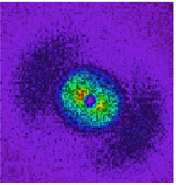 By confining polymer chain in nano-meter-sized space separated by surfactant
membrane, the membrane changes their morphology to optimize the conformational
entropy of polymer chains or the specific interaction between surfactant
and polymer. For example, microemulsion droplets can confine the polymer
chains inside of the closed nano-space by selecting the solubility of the
polymer to the solvent. In such a strongly confined system, we observed
a series of morphology transitions of microemulsion droplets as a function
of the degree of polymer confinement. In addition we observed a unique
morphology transition when the polymer undergoes a sol-gel transition inside
the nano-space.
By confining polymer chain in nano-meter-sized space separated by surfactant
membrane, the membrane changes their morphology to optimize the conformational
entropy of polymer chains or the specific interaction between surfactant
and polymer. For example, microemulsion droplets can confine the polymer
chains inside of the closed nano-space by selecting the solubility of the
polymer to the solvent. In such a strongly confined system, we observed
a series of morphology transitions of microemulsion droplets as a function
of the degree of polymer confinement. In addition we observed a unique
morphology transition when the polymer undergoes a sol-gel transition inside
the nano-space.
[Related papers]
Polymer-Confinement-Induced Nematic Transition of Microemulsion Droplets
K. Nakaya, M. Imai, S. Komura, T. Kawakatsu, and N. Urakami
Europhysics Letters,71, 494-500 (2005).
Effects of Grafted Polymer Chains on Lamellar Membranes
T. Masui, M. Imai, K. Nakaya and T. Taniguchi
J. Chem. Phys. 124, 074904 (1-12) (2006).
Molecular dynamics simulation for morphological change of water-in-oil microemulsion droplets induced by addition of polymer chains
T. Kurokawa, N. Urakami, K. Nakaya-Yaegashi, A. Sakashita, M. Imai, and T. Yamamoto
Soft Matter 7, 7504-7510 (2011).
3)Depletion interaction in rod particle and semi-flexible polymer mixture
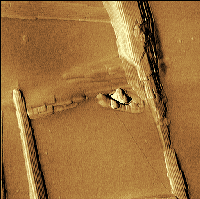 The most familiar entropic interaction induced by the guest particles
is the depletion interaction, i.e. attractive interaction between host
particles. Thus, by overlapping the depletion zone surrounding the host
particles the guest particles obtain large free volume. The increase of
the free volume raises the translational entropy of guest particles, but
at the expense of lowering the entropy of mixing. In the case of rod particle
and semi-flexible polymer mixture, the rods start to aggregate at the very
dilute concentration (less than 0.1 mg/ml), which is an extreamly enhanced
depletion effect.
The most familiar entropic interaction induced by the guest particles
is the depletion interaction, i.e. attractive interaction between host
particles. Thus, by overlapping the depletion zone surrounding the host
particles the guest particles obtain large free volume. The increase of
the free volume raises the translational entropy of guest particles, but
at the expense of lowering the entropy of mixing. In the case of rod particle
and semi-flexible polymer mixture, the rods start to aggregate at the very
dilute concentration (less than 0.1 mg/ml), which is an extreamly enhanced
depletion effect.
[Related papers]
The Isotropic-Nematic Transition and the Phase Separation of the Tabacco Mosaic Virus Particles with Polysaccharide
N. Urakami, M. Imai, Y. Sano and M. Takasu
J. Chem. Phys. 111, 2322-2328 (1999).
Polysaccharides Induced Crystallization of TMV Particles
M. Imai, N. Urakami, A. Nakamura, R. Takada, R. Oikawa and Y. Sano
Langmuir 18, 9918-9923 (2002).
The Dependence of Sphere Size on the Phase Behaviors for the Mixture of Rods and Spheres.
N. Urakami and M. Imai
J. Chem. Phys. 119, 2463-2470 (2003).